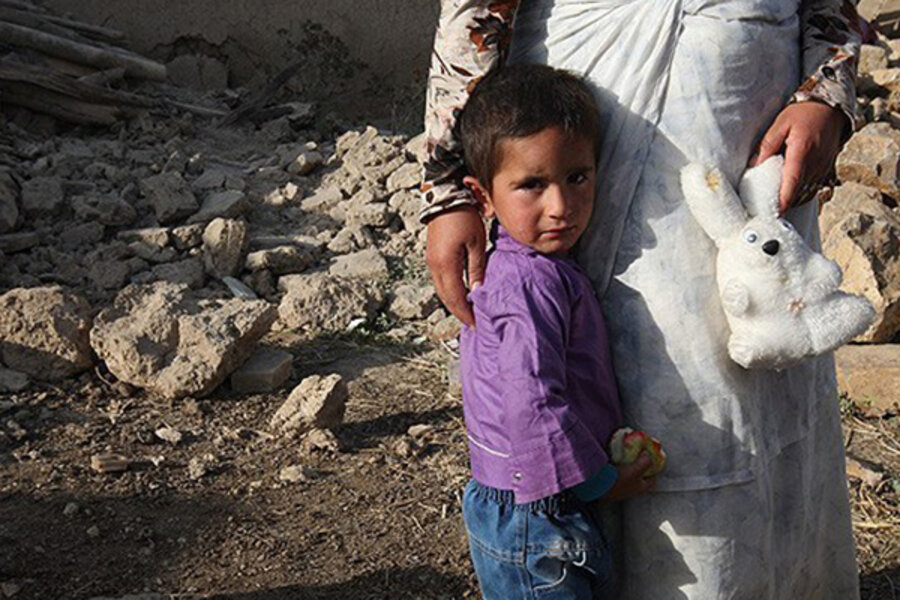Iran's government criticized over earthquake response
Loading...
| Dubai, United Arab Emirates
Iran's government faced criticism from lawmakers and the public on Monday over its handling of relief efforts after two large earthquakes killed 300 people and injured thousands in the northwest of the country.
Members of parliament representing the affected areas complained about the shortage of tents for survivors, parliamentary news agency ICANA said on Monday, and Iran's top lawmaker Ali Larijani stepped into the debate.
"The crisis management headquarters must take broader steps to alleviate these concerns," Larijani, a rival to President Mahmoud Ahmadinejad and possible candidate in the 2013 presidential elections, was quoted as saying on Monday.
Although officials announced on Sunday, less than 24 hours after the disaster, that search and rescue operations had finished and all survivors had been freed from the rubble, some residents expressed disbelief that authorities could have reached some of the most remote villages so soon.
"I know the area well. There are some regions where there are villages that you can't even reach by car," one doctor in the city of Tabriz told Reuters by telephone on Monday, declining to give his name because of the sensitivity of the issue. "It's not possible for them to have finished so soon."
Citizens step up
The doctor said he had worked for 24 hours non-stop following the quake, attending to patients from surrounding villages who were rushed to Tabriz for medical care.
"In the first hours after the quake, it was ordinary people and volunteers in their own cars going to the affected areas," the doctor said. "It was more ordinary people helping out than official crisis staff."
The moderate conservative newspaper Asr-e Iran reported that a full 24 hours after the earthquake, some villages had not yet been visited by relief teams.
"[Residents] say that most of the villages have been destroyed and still no tents have been sent, nor has any help been sent for the victims," the report said.
Two large quakes with magnitudes of 6.4 and 6.3 struck East Azerbaijan province on Saturday afternoon, flattening villages and injuring thousands around the towns of Ahar, Varzaghan, and Harees, near the provincial capital of Tabriz.
Officials deny sluggishness
Officials said the emergency response to the disaster was rapid, even though relief teams were hampered by the remoteness of quake-hit villages.
"We will rebuild these areas before the start of the winter," Hassan Ghadami, an emergency management official in the Interior Ministry, told lawmakers on Monday, Iran's state news agency IRNA reported.
The mud-brick construction of many village buildings was to blame for the wide destruction, he said.
"Relief forces were despatched in a normal and natural way and they were despatched to the affected areas quickly," Ghadami was quoted as saying by Iranian agencies.
Reza Sheibani, a Tabriz resident who owns a 24-hour pharmacy in Ahar, told Reuters by telephone that the government had acted well in deploying security forces to ensure public order in the panicked hours after the quakes.
Ahmadinejad abroad
President Mahmoud Ahmadinejad left as planned on Monday morning for Saudi Arabia, where he is to attend a meeting of the Organization of Islamic Cooperation (OIC) expected to focus on the crisis in Syria.
But his overseas trip exposed him to criticism at home that he was not showing empathy with the disaster victims.
In an editorial titled "Mr. Ahmadinejad, where have you gone?" Asr-e Iran criticised his decision to leave the country with his closest advisers less than two days after the quakes.
"In every other part of the world, the tradition is that when natural disasters happen, leaders will change their plans and visit the affected areas in order to show their compassion ... and observe rescue efforts," Asr-e Iran wrote.
Tabriz residents and legislators also criticised state-run television's early coverage of the disaster, saying it did not reflect the extent of the damage in the first hours.
Minority backwater?
The lack of coverage, some said, contributed to a sense that the central government in Tehran did not care much about the people of northwest Iran, most of whom are Azeri Turks, the biggest ethnic minority in the country.
"Even though (on Saturday night) hundreds of people were under the rubble, on the television broadcasts ... there was no mention of the disaster," said Alireza Manadi Safidan, a legislator representing Tabriz, according to the Iranian Students' News Agency (ISNA).
"[State television] was busy counting how many medals Iran won" in the Olympics, the doctor in Tabriz said. "They didn't have any reaction to this event."
Larijani said on Monday that state television ought to better reflect the country's sympathies for the earthquake victims, ICANA reported.
* Additional reporting by Rania El Gamal in Dubai; Editing by Jon Hemming.





